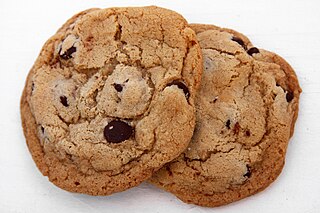
A cookie is a baked or cooked snack or dessert that is typically small, flat and sweet. It usually contains flour, sugar, egg, and some type of oil, fat, or butter. It may include other ingredients such as raisins, oats, chocolate chips, nuts, etc.
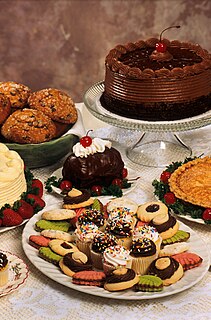
Dessert is a course that concludes a meal. The course consists of sweet foods, such as confections, and possibly a beverage such as dessert wine and liqueur. In some parts of the world, such as much of Central Africa and West Africa, and most parts of China, there is no tradition of a dessert course to conclude a meal.

Shortcrust pastry is a type of pastry often used for the base of a tart, quiche, pie, or flan. Shortcrust pastry can be used to make both sweet and savory pies such as apple pie, quiche, lemon meringue or chicken pie.

Pastry is baked food made with a dough of flour, water and shortening that may be savoury or sweetened. Sweetened pastries are often described as bakers' confectionery. The word "pastries" suggests many kinds of baked products made from ingredients such as flour, sugar, milk, butter, shortening, baking powder, and eggs. Small tarts and other sweet baked products are called pastries. Common pastry dishes include pies, tarts, quiches, croissants, and pasties.

A pie is a baked dish which is usually made of a pastry dough casing that contains a filling of various sweet or savoury ingredients. Sweet pies may be filled with fruit, nuts, brown sugar, sweetened vegetables, or with thicker fillings based on eggs and dairy. Savoury pies may be filled with meat, eggs and cheese (quiche) or a mixture of meat and vegetables.
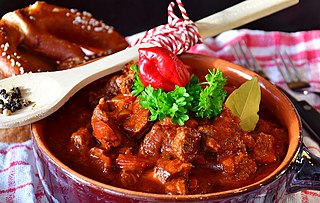
Hungarian or Magyar cuisine is the cuisine characteristic of the nation of Hungary and its primary ethnic group, the Magyars. Traditional Hungarian dishes are primarily based on meats, seasonal vegetables, fruits, bread, and dairy products.

A scone is a baked good, usually made of either wheat or oatmeal with baking powder as a leavening agent, and baked on sheet pans. A scone is often slightly sweetened and occasionally glazed with egg wash. The scone is a basic component of the cream tea. It differs from teacakes and other types of sweets that are made with yeast. Scones were chosen as the Republic of Ireland representative for Café Europe during the Austrian Presidency of the European Union in 2006, while the United Kingdom chose shortbread.

A muffin is an individually portioned baked product, however the term can refer to one of two distinct items: a part-raised flatbread that is baked and then cooked on a griddle, or an quickbread that is chemically leavened and then baked in a mold. While quickbread "American" muffins are often sweetened, there are savory varieties made with ingredients such as corn and cheese, and less sweet varieties like traditional bran muffins. The flatbread "English" variety is of British or other European derivation, and dates from at least the early 18th century, while the quickbread originated in North America during the 19th century. Both types are common worldwide today.
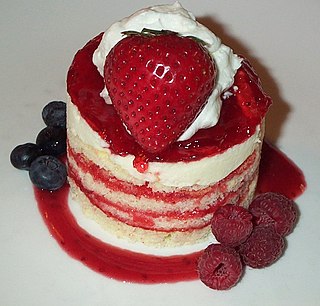
Shortcake generally refers to a sweet cake or crumbly biscuit in the American sense. Shortcakes, particularly layered with strawberries and whipped cream, are now found world-wide, but generally considered to be North American in origin. Variations between sweet biscuits and something more like a sponge cake may reflect regional preferences. Japanese strawberry cake tends to use a sponge cake base, and is a popular holiday treat in Japan.

Cobbler is a dessert consisting of a fruit filling poured into a large baking dish and covered with a batter, biscuit, or dumpling before being baked. Some cobbler recipes, especially in the American South, resemble a thick-crusted, deep-dish pie with both a top and bottom crust. Cobbler is part of the cuisine of the United Kingdom and United States, and should not be confused with a crumble.
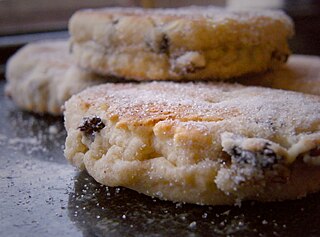
Welsh cakes, also bakestones or pics, are a traditional sweet bread in Wales. They have been popular since the late 19th century with the addition of fat, sugar and dried fruit to a longer standing recipe for flat-bread baked on a griddle.

A teacake in England is generally a light yeast-based sweet bun containing dried fruit, typically served toasted and buttered. In the U.S. teacakes can be cookies or small cakes. In Sweden, they are soft, round, flat wheat breads made with milk and a little sugar, and used to make buttered ham or cheese sandwiches. In India and Australia, a teacake is more like a butter cake. Tea refers to the popular beverage to which these baked goods are an accompaniment.

Chorley cakes are flattened, fruit filled pastry cakes, traditionally associated with the town of Chorley in Lancashire, England.

Lardy cake, also known as lardy bread, lardy Johns, dough cake and fourses cake is a traditional rich spiced form of bread found in several southern counties of England, each claiming to provide the original recipe. It remains a popular weekend tea cake in the southern counties of England, including Sussex, Surrey, Hampshire, Berkshire, Wiltshire, Dorset and Gloucestershire.

A rock cake, also called a rock bun, is a small cake with a rough surface resembling a rock. They were promoted by the Ministry of Food during the Second World War since they require fewer eggs and less sugar than ordinary cakes, an important savings in a time of strict rationing. Traditional recipes bulked them with oatmeal, which was more readily available than white flour.

Sponge cake is a light cake made with egg whites, flour and sugar, sometimes leavened with baking powder. Sponge cakes, leavened with beaten eggs, originated during the Renaissance, possibly in Spain. The sponge cake is thought to be one of the first of the non-yeasted cakes, and the earliest attested sponge cake recipe in English is found in a book by the English poet Gervase Markham, The English Huswife, Containing the Inward and Outward Virtues Which Ought to Be in a Complete Woman (1615). Still, the cake was much more like a cracker: thin and crispy. Sponge cakes became the cake recognized today when bakers started using beaten eggs as a rising agent in the mid-18th century. The Victorian creation of baking powder by English food manufacturer Alfred Bird in 1843 allowed the addition of butter to the traditional sponge recipe, resulting in the creation of the Victoria sponge.
A singing hinny or singin' hinny is a type of bannock, griddle cake or scone, made in the north of England, especially Northumberland and the coal-mining areas of the North East. In Scotland, they are known as fatty cutties.
















